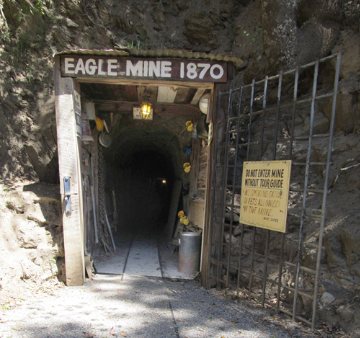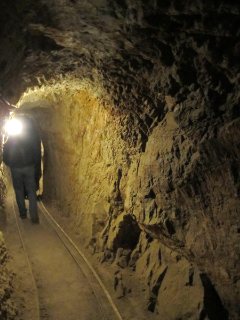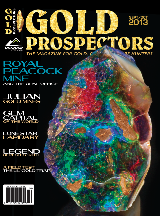Eagle and High Peak Gold Mine Tour in Julian, CaliforniaDon’t let the “armed sentry on duty” and other signs warning against trespassing scare you off. Despite first impressions, a dusty driveway at the end of C Street leads to a golden opportunity to go underground into authentic hard rock gold mines. Located in Julian, California, the Eagle and High Peak Mines were dug out of a mountain with picks and shovels more than a 140 years ago. Ownership of these patented claims has changed hands over the years, but since the 1960s the property has belonged to the Nelson family. Although local schools schedule field trips here to show kids first hand about their state’s mining history, don’t expect a Disney-type tour. What you get from a no-nonsense knowledgeable guide, whom most likely will be Karl Nelson, one of the owners, is a comprehensive explanation of hard rock mining in general, and the history of the Eagle and High Peak Mines in particular. A mother lode of information is provided in just one hour, so whether you’re a mining novice or an expert, you are sure to learn something new as you walk in the footsteps of the old-time hard rock miners. The story here begins 20 years after Coloma’s famous 1849 Gold Rush. The precious metal was discovered in Julian during the winter of 1869-70 when cattleman Fred Coleman found the first flecks of bright placer gold in a creek. The ensuing excitement then set off San Diego County's own gold rush. Before long, there were 200 hard rock claims in the area, but by 1906, most mines were unprofitable and abandoned. Many of the folks stayed on, though, and began farming the fertile land and raising livestock. Julian proved to have an especially good climate for growing apples, and still does now. In fact, Julian is known as the place to visit each fall when fruit stands are overflowing with crisp apples, and homemade cider and pies lure in scores of San Diegans from the big city about 60 miles away. No matter the season, before or after your mine tour, be sure to stop in historic downtown Julian for a piece of famous apple pie. You’ll also find a Pioneer Museum, a variety of small shops, and the Gold Rush Hotel Bed & Breakfast. A make shift sign that hangs above the entrance to the Eagle Mine attests to the year that William Moran followed a quartz vein up the mountain— 1870— and as they say, the rest is history. Hard rock mining was very slow and laborious back then. Miners could only dig two to four feet a day, and unless there was at least one ounce of gold per ton of rock, there would be no profit. Luckily, Mr. Moran’s assayer gave him good news, so after a while he and his partners hired a few extra men to help work the mines. Although it was a decent living, and miners were always hopeful that the next blast of explosives or swing of their pickaxe would reveal a fortune, no one got really rich. Both mines were worked seriously for about 40 years, and each produced a few thousand ounces of gold. During this period, the value of gold hovered around $20.65 per ounce. The last time the mines were worked commercially was right before WWII, which was when all mining efforts were halted. After the War, open pit mining with heavy equipment became the only way to make good money.
As you follow your tour guide through the mine, expect to make quite a few stops to listen to the interesting commentary, investigate side tunnels, take photos, and get a closer look at mining relics. Notice the slight uphill grade as you walk alongside the original ore car tracks. To make mining cheaper and easier, old-timers befriended the force of gravity. Pushing empty ore carts uphill, and full ones down only made sense and cents. The slope also meant water could more easily drain out. In all, 4,000 feet of tunnels and 11 levels comprise the Eagle and High Peak Mines. There are five levels above where you walk, and five below, with a maximum depth of 425 feet. What’s also particularly unique about this tour is that climbing a set of stairs allows you to explore more than just one floor. Most mine tours lead visitors just a short distance and on only one level. The Eagle and High Peak Mines were not always connected. The spot where the tunnel becomes wider and taller indicates the end of the Eagle Mine. At the conclusion of the tour, you’ll exit out the High Peak and walk a short distance back down the hill. Although adjacent, these two mines did not share their gold, they simply shared equipment and the nearby stamp mill, which is the last stop on the outdoor portion of the tour. Throughout the mine, notice the old ore buckets, picks, tamping bars and many other tools. In the Hoist Room, you’ll see the machinery that hauled the ore buckets between levels of the mine via cables, and learn how signal bells were used for communication. An original foreman’s desk is still in the mine, as well as an air-powered drill. This machine was commonly referred to as a “widow maker.” Many miners died young from silicosis, caused by dust produced by this type of drill. Water was eventually used to keep the dust down, but of course it still wasn’t the healthiest of work environments. Contrary to what you might think, cave-ins were rare. If the rock was fractured, timbers were used to shore up the tunnel. The original timbers are still here. Although dim bulbs light the route now, the original miners did not have electricity. At first they worked by candlelight, and later they wore hard hats affixed with carbide lanterns. The miners even had to buy their own candles! To save money, miners would generally not use any light until they arrived at their work area. Try to imagine stumbling down a rock tunnel in total darkness, guided only by the ore cart tracks at your feet. Miners would keep one hand in the air as they walked so they knew when to duck their heads, and then would light a candle only when they started work. When the tour guide turns off the lights for a quick moment, you’ll get a good comprehension of true pitch black. After the ore carts were filled with rock and pushed out of the mine, their next stop was the stamp mill where the rock was crushed to release the gold. The weights on the newly painted bright red 5-stamp mill provided 1,000 pounds of crushing force. A mill this size crushed 10 tons of rock every 24 hours. Notice the examples of old and new weights on display. It’s amazing how solid iron can be worn down from constant pounding. The old timers sure could have used a modern day rock crusher, that's for sure! After being crushed, the resulting gravel was then processed on shaker tables. You might be surprised to learn that a clean up was done only once per month. After rinsing, the carpets (miners moss) were burned and then the ashes were panned. Every grain adds up! Mercury was also used to extract gold (and silver) at this operation. The tour concludes with a quick lesson from your guide on how to pan for gold. You can easily skip this tutorial and instead poke around the eclectic collection of antique cars, trucks, hand-crank washing machines, and mining relics scattered about the parking area. Old photographs, stock certificates, and ore samples can be found in the office/museum where you pay for the tour, along with a rare display of old mercury retorts.
IF YOU GO: End of C Street in Julian, California 92036 (760) 765-0036 This article was written by Denise Seith and appeared in the September/October 2013 issue of Gold Prospector Magazine, published by the Gold Prospectors Association of America (GPAA). |
|
|




